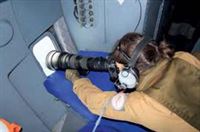Фотографии
-
Egyptian Navy Corvette El Fateh gets a once over from an Atlantique 2 over the Mediterranian.
Самолёты на фотографии: Breguet Br.1150 Atlantique - Франция - 1961
-
This shot demonstrates the acute nose-down attitude of the Atlantique 2 when landing. The high-aspect ratio wing develops loads of lift, which sometimes makes landing problematic.
Самолёты на фотографии: Breguet Br.1150 Atlantique - Франция - 1961
-
The aircraft's load of sonobuoys is carried in dispensers covered by the two open doors behind the weapons bay.
Самолёты на фотографии: Breguet Br.1150 Atlantique - Франция - 1961
-
The clam shell doors covering the Rolls-Royce Tyne engines were designed to provide ease of access for maintenance.
Самолёты на фотографии: Breguet Br.1150 Atlantique - Франция - 1961
-
Ground crew prod a sonobuoy into place.
Самолёты на фотографии: Breguet Br.1150 Atlantique - Франция - 1961
-
As can be seen in this head on shot, the Atlantique 2 is designed with a 'double-bubble' fuselage. The upper lobe contains a pressurised crew compartment, and the lower a 27ft 6in (9m) weapons bay.
Самолёты на фотографии: Breguet Br.1150 Atlantique - Франция - 1961
-
Vapour vortices trail behind Atlantique 2 No.27 as it takes off from Lann-Bihoue at the start of another long patrol.
Самолёты на фотографии: Breguet Br.1150 Atlantique - Франция - 1961
-
Weapons handlers in their distinctive red vests manoeuvre a Paveway II training round into position ready for flight.
Самолёты на фотографии: Breguet Br.1150 Atlantique - Франция - 1961
-
Decoy flares are deployed from fuselage-mounted containers.
Самолёты на фотографии: Breguet Br.1150 Atlantique - Франция - 1961
-
Atlantique 2 No.27 of 23F being towed at its Lann-Bihoue base with the doors to its capacious weapons bay open.
Самолёты на фотографии: Breguet Br.1150 Atlantique - Франция - 1961
-
Both Atlantique 2 squadrons, Flottilles 21F and 23F, are now stationed at Lann-Bihoue since the closure of Nimes-Garons. The type will remain in service for the foreseeable future.
Salt is a killer of airframes, which is why this Atlantique 2 is visiting the wash-rack after returning from a low-level sortie over the sea.Самолёты на фотографии: Breguet Br.1150 Atlantique - Франция - 1961
-
Decoy flares are deployed from fuselage-mounted containers.
Самолёты на фотографии: Breguet Br.1150 Atlantique - Франция - 1961
-
A view from the flight engineer's position of the flight deck of an Atlantique 2 prior to modernisation.
Самолёты на фотографии: Breguet Br.1150 Atlantique - Франция - 1961
-
The most obvious difference from the old-style flight deck to be seen in this image of an upgraded aircraft is the new glass cockpit. Two digital screens for each pilot replace the previously fitted analogue dials, providing primary flight data and other useful information.
Самолёты на фотографии: Breguet Br.1150 Atlantique - Франция - 1961
-
The darkened rear cabin is the domain of the tactical crew that usually comprises eight technicians, the tactical coordinator (TACCO) and his or her deputy, two radar and electronic support measures officers and two acoustic sensor officers. The TACCOs have identical workstations, both of which have two full-colour digital displays. The TACCO monitors inputs from sensors to determine necessary action. The deputy manages communications, navigation and electro-optical systems.
Самолёты на фотографии: Breguet Br.1150 Atlantique - Франция - 1961
-
A crew member uses a digital single-lens reflex camera fitted with a long 300-800mm lens for surveillance. The camera is connected to computers in the rear cabin for rapid analysis of images taken.
Самолёты на фотографии: Breguet Br.1150 Atlantique - Франция - 1961
Статьи
- -
- Airscene
- Backpages
- News by countries
- A.Mladenov - Mi-26: still alive and kicking /Military/
- A.Spaeth - Small island, big jets /Commercial/
- D.Isby - Chinooks for the future? Chinooks facing upgrade challenges /Military/
- D.Isby - Flying F-16s to 2048. Upgrading a US Air Force classic /Military/
- D.Marcellino - AW169 in Italy /Parapublic/
- H.-P.Grolleau - Atlantique 2 into combat /Military/
- J.Gunner - King Stallion /Military/
- K.van der Mark - Air manoeuvres /Military/
- M.Broadbent - Riders of the storms /Parapublic/
- M.Broadbent - Toulouse's latest twin /Commercial/
- R.Niccoli - Complex aviation /Military/















